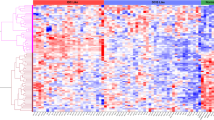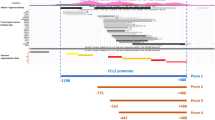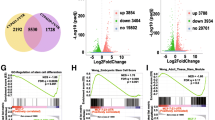Abstract
It is well-established that CYP24, an immediate target gene of VDR is upregulated by VDR ligands. This study is focused on the functional role of unliganded VDR by investigating the correlation between the expression of VDR protein and basal mRNA levels of CYP24 in breast cancer cell lines. Analyses of multiple breast cancer cell lines demonstrated an inverse correlation between VDR protein expression and CYP24 mRNA expression levels; while in the presence of ligand, VDR protein level was positively correlated with CYP24 expression. In MCF-7 cells, VDR was mainly distributed in the nuclei in the absence of ligand. VDR overexpression in MCF-7 cells and MDA-MB231 cells decreased CYP24 mRNA expression levels and CYP24 promoter activity. Conversely, knock-down of VDR using siRNA techniques in MCF-7 and T47D cells significantly increased CYP24 mRNA expression. We also found that overexpression of VDR with a polymorphic site (FokI-FF) at its AF-1 domain, which makes VDR shorter by three amino acids, failed to repress CYP24 promoter activity. This report provides conclusive evidence for the repressive action of unliganded VDR on the expression of its target gene CYP24 and the importance of an intact VDR AF-1 domain for its repressive action.




Similar content being viewed by others
Abbreviations
- VDR:
-
Vitamin D receptor
- RT–PCR:
-
Reverse transcription–polymerase chain reaction
- TR:
-
Thyroid hormone receptor
- RAR:
-
Retinoic acid receptor
- RXR:
-
Retinoid X receptor
- AF-1:
-
Activation function-1
References
Hewison M, Dabrowski M, Vadher S, Faulkner L, Cockerill FJ, Brickell PM, O’Riordan JL, Katz DR (1996) Antisense inhibition of vitamin D receptor expression induces apoptosis in monoblastoid U937 cells. J Immunol 156:4391–4400
Guzey M, Jukic D, Arlotti J, Acquafondata M, Dhir R, Getzenberg RH (2004) Increased apoptosis of periprostatic adipose tissue in VDR null mice. J Cell Biochem 93:133–141
Blumberg JM, Tzameli I, Astapova I, Lam FS, Flier JS, Hollenberg AN (2006) Complex role of the vitamin D receptor and its ligand in adipogenesis in 3T3-L1 cells. J Biol Chem 281:11205–11213
Tolón RM, Castillo AI, Jiménez-Lara AM, Aranda A (2000) Association with Ets-1 causes ligand- and AF2-independent activation of nuclear receptors. Mol Cell Biol 20:8793–8802
Prüfer K, Barsony J (2006) Retinoid X receptor dominates the nuclear import and export of the unliganded vitamin D receptor. Mol Endocrinol 16:1738–1751
Prüfer K, Racz A, Lin GC, Barsony J (2000) Dimerization with retinoid X receptors promotes nuclear localization and subnuclear targeting of vitamin D receptors. J Biol Chem 275:41114–41123
Chen JD, Evans RM (1995) A transcriptional co-repressor that interacts with nuclear hormone receptors. Nature 377:454–457
Hörlein AJ, Näär AM, Heinzel T, Torchia J, Gloss B, Kurokawa R, Ryan A, Kamei Y, Söderström M, Glass CK et al (1995) Ligand-independent repression by the thyroid hormone receptor mediated by a nuclear receptor co-repressor. Nature 377:397–404
Zamir I, Harding HP, Atkins GB, Hörlein A, Glass CK, Rosenfeld MG, Lazar MA (1996) A nuclear hormone receptor corepressor mediates transcriptional silencing by receptors with distinct repression domains. Mol Cell Biol 16:5458–5465
Jones G, Strugnell SA, DeLuca HF (1998) Current understanding of the molecular actions of vitamin D. Physiol Rev 78:1193–1231
Mangelsdorf DJ, Evans RM (1998) The RXR heterodimers and orphan receptors. Cell 83:841–850
Masuyama H, Brownfield CM, St-Arnaud R, MacDonald PN (1997) Evidence for ligand-dependent intramolecular folding of the AF-2 domain in vitamin D receptor-activated transcription and coactivator interaction. Mol Endocrinol 11:1507–1517
Sone T, Kerner S, Pike JW (1991) Vitamin D receptor interaction with specific DNA. Association as a 1, 25-dihydroxyvitamin D3-modulated heterodimer. J Biol Chem 266:23296–23305
Tashiro K, Ishii C, Ryoji M (2007) Role of distal upstream sequence in vitamin D-induced expression of human CYP24 gene. Biochem Biophys Res Commun 358:259–265
Peng X, Jhaveri P, Hussain-Hakimjee EA, Mehta RG (2007) Overexpression of ER and VDR is not sufficient to make ER-negative MDA-MB231 breast cancer cells responsive to 1α-hydroxyvitamin D5. Carcinogenesis 28:1000–1007
Peng X, Mehta R, Wang S, Chellappan S, Mehta RG (2006) Prohibitin is a novel target gene of vitamin D involved in its antiproliferative action in breast cancer cells. Cancer Res 66:7361–7369
Peng X, Maruo T, Cao Y, Punj V, Mehta R, Das Gupta TK, Christov K (2004) A novel RARbeta isoform directed by a distinct promoter P3 and mediated by retinoic acid in breast cancer cells. Cancer Res 64:8911–8918
Sutton AL, MacDonald PN (2003) Vitamin D: more than a “bone-a-fide” hormone. Mol Endocrinol 17:777–791
Kim JY, Son YL, Lee YC (2009) Involvement of SMRT corepressor in transcriptional repression by the vitamin D receptor. Mol Endocrinol 23:251–264
Hartman HB, Yu J, Alenghat T, Ishizuka T, Lazar MA (2005) The histone-binding code of nuclear receptor co-repressors matches the substrate specificity of histone deacetylase 3. EMBO Rep 6:445–451
Zheng ZY, Zheng SM, Bay BH, Aw SE, Lin C-L V (2008) Anti-estrogenic mechanism of unliganded progesterone receptor isoform B in breast cancer cells. Breast Cancer Res Treat 110:111–125
Cvoro A, Tzagarakis-Foster C, Tatomer D, Paruthiyil S, Fox MS, Leitman DC (2006) Distinct roles of unliganded and liganded estrogen receptors in transcriptional repression. Mol Cell 21:555–564
Xiao N, DeFranco DB (1997) Overexpression of unliganded steroid receptors activates endogenous heat shock factor. Mol Endocrinol 11:1365–1374
Whitfield GK, Remus LS, Jurutka PW, Zitzer H, Oza AK, Dang HT, Haussler CA, Galligan MA, Thatcher ML, Encinas Dominguez C, Haussler MR (2001) Functionally relevant polymorphisms in the human nuclear vitamin D receptor gene. Mol Cell Endocrinol 177:145–159
Arai H, Miyamoto K, Taketani Y, Yamamoto H, Iemori Y, Morita K, Tonai T, Nishisho T, Mori S, Takeda E (1997) A vitamin D receptor gene polymorphism in the translation initiation codon: effect on protein activity and relation to bone mineral density in Japanese women. J Bone Miner Res 12:915–921
Gross C, Krishnan AV, Malloy PJ, Eccleshall TR, Zhao XY, Feldman D (1998) The vitamin D receptor gene start codon polymorphism: a functional analysis of FokI variants. J Bone Miner Res 13:1691–1699
Polly P, Herdick M, Moehren U, Baniahmad A, Heinzel T, Carlberg C (2000) VDR-Alien: a novel, DNA-selective vitamin D(3) receptor-corepressor partnership. FASEB J 14:1455–1463
Sinkkonen L, Malinen M, Saavalainen K, Väisänen S, Carlberg C (2005) Regulation of the human cyclin C gene via multiple vitamin D3-responsive regions in its promoter. Nucleic Acids Res 33:2440–2451
Guy M, Lowe LC, Bretherton-Watt D, Mansi JL, Peckitt C, Bliss J, Wilson RG, Thomas V, Colston KW (2004) Vitamin D receptor gene polymorphisms and breast cancer risk. Clin Cancer Res 10:5472–5481
Yen PM, Liu Y, Sugawara A, Chin WW (1996) Vitamin D receptors repress basal transcription and exert dominant negative activity on triiodothyronine-mediated transcriptional activity. J Biol Chem 271:10910–10916
Dwivedi PP, Muscat GE, Bailey PJ, Omdahl JL, May BK (1998) Repression of basal transcription by vitamin D receptor: evidence for interaction of unliganded vitamin D receptor with two receptor interaction domains in RIP13∆1. J Mol Endocrinol 20:327–335
Acknowledgments
This study was supported by NCI Public Health Service Grant CA 82316 (R. G. M.) and NCI R03 CA121365-02 (X. P.). F.A. is supported by the Ruth L. Kirschstein predoctoral fellowship (1F31CA13261903). B.A is a VA research Career Scientist and is supported by a VA Merit-Review grant.
Author information
Authors and Affiliations
Corresponding author
Rights and permissions
About this article
Cite this article
Alimirah, F., Vaishnav, A., McCormick, M. et al. Functionality of unliganded VDR in breast cancer cells: repressive action on CYP24 basal transcription. Mol Cell Biochem 342, 143–150 (2010). https://doi.org/10.1007/s11010-010-0478-6
Received:
Accepted:
Published:
Issue Date:
DOI: https://doi.org/10.1007/s11010-010-0478-6




